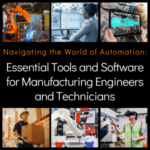Fulfilling the Demand for Automation in Today’s Market
I was approached recently by one of my colleagues to contribute to this article focused on unemployment in the automation industry. He asked me if I knew what the demand was for controls engineers in today’s market. I thought this would be an excellent topic to write a blog on as there is a wide spectrum of automation-related positions out on the market. Large search engines with thousands of different job titles can be difficult to filter through and it is nearly impossible to quantify the number of true openings for any individual job title.
Since Automationtechies is a small firm within the automation industry, I cannot accurately judge the number of job openings for a specific job title such as controls engineers. However, I have been observing the market over the years and can say the percentage of expected growth for open automation related jobs based on a few factors.

Our company typically has between 80-90 open automation job positions at any given point in time. Currently, we have 124 job openings and the number of controls engineering positions changes daily. I’ve spoken recently with Control Systems Integrators (CSI), Machine Builders, Automation Product Manufacturers, and others from companies that hire automation people. Based on the increase in job openings we have at our firm and these conversations from companies in the industry, there will likely be a 20%-25% increase in the number of open automation positions in comparison to a year ago. One of our large CSI clients stated they have over 20 open positions at this time. A medium-sized Automation Product manufacturer recently told me they have over 100 openings (Applications Engineers, Product Specialist, Sales, etc.) right now. Without having any definitive data, I think it’s obvious we are currently experiencing a huge shortfall of candidates to fill all these open jobs.
How will companies meet their growing needs for engineering positions? The answer to this question is simple but not necessarily easy. Companies must start to focus on workforce development and begin investing in up-and-coming engineers and technical professionals rather than only choosing candidates that already within the existing workforce. As a recruiter, it is my job to find people who are currently in the automation workforce and place them in roles for clients. There will always be times where companies who hire automation people obviously need to hire from within the workforce for positions that require more industry experience. However, these companies also need to begin adding new people into this workforce. There are a few ways to achieve this task.
F1 Visas
Every year in the United States, there is a large pool of college students graduating with master’s degrees who are here from other countries on F1 (student) Visas. These candidates can stay in the US and work under an F1-OPT (Optional Practical Training) status for 12 months PLUS 24 months if they graduate with a STEM degree. Some of these candidates even have prior work experience from their home country. In the past few years, we have tried very hard to help some of these graduates find jobs in automation. Unfortunately, many of them either end up working for other tech companies, like Amazon or Google, or end up having to return to their country of origin. Employers who give these candidates the opportunity to work those 3 years without sponsorship can easily evaluate the candidate and put them on a path to stay longer.
Internships
Recruit directly from colleges and offer internships to fill the demand for automation people. Engineering students are far more likely to work with the company they complete an internship for after they graduate. Internships also provide students the chance to apply their knowledge and get hands on experience to help prepare them for future jobs in the workforce.
STEM Outreach Programs
Support STEM outreach programs to help steer young people into engineering degrees. FIRST Robotics Teams are a great place the start. At Automationtechies we not only financially support our local FIRST Robotics Team, we also help connect them with some of our clients who also now supporters, and we donate all our retired computers to their team.
Company Culture
Work to establish a culture within the company that will be attractive to new grads. Pay attention to what younger people who are new to the workforce want in an employer and try to provide it. There are many non-automation, high-tech companies who do this extremely well while very few automation companies have become proficient at this.
From my viewpoint within the field, I believe the shortfall of candidates within automation engineering field will continue to grow. Companies need to focus on workforce development in order to support the automation community and increase the available workforce for industrial automation positions. We must work together to attract, develop, and inspire the next generation of engineers and help meet the growing demand for automation people.
This blog is in response to an article written by Bill Pollock, president and CEO of Optimation Technology Inc. For more information, read the full article on Automation World.





